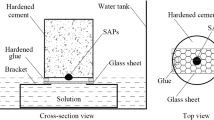Abstract
Re-swelling capacity is a key factor influencing the self-sealing efficiency of superabsorbent polymers (SAPs) in concrete. In this paper, a new parameter (re-swelling ratio, η), the volume ratio of the crack which was filled with the expansive SAPs and the dry SAPs, was given to quantify the re-swelling capacity of a single SAPs particle. An innovative immersion test was used to study the η value of SAPs in the hardened cement paste with an artificial crack. Moreover, the influence of the crack width and particle size on the sealing efficiency of SAPs in the cracked paste was investigated by a water permeability test. The results showed that the mass ratios of the expansive SAPs in an artificial crack were less than those in a free state. The η value of SAPs in the hardened paste with an artificial crack increased with the increase of the crack width due to the restricting effects of the crack. The expansive SAPs in the cracked paste could totally seal or partly seal the crack within the original void. Moreover, the sealing efficiency of SAPs slightly increased with the rise of the crack width (0.25 to 0.5 mm) and the reduction of the particle size. This research demonstrates that the crack width in concrete and the particle size of SAPs are the key factors influencing the re-swelling behavior of SAPs which should be taken into consideration when designing the self-sealing concrete containing SAPs.
Similar content being viewed by others
References
Van Tittelboom K, Wang J, Araújo M, et al. Comparison of Different Approaches for Self-Healing Concrete in A Large-Scale Lab Test[J]. Constr. Build. Mater., 2016, 107: 125–137
Kua H W, Gupta S, Aday A N, et al. Biochar-immobilized Bacteria and Superabsorbent Polymers Enable Self-Healing of Fiber-Reinforced Concrete after Multiple Damage Cycles[J]. Cem. Concr. Compos., 2019, 100: 35–52
Deng H, Liao G. Assessment of Influence of Self-Healing Behavior on Water Permeability and Mechanical Performance of ECC Incorporating Superabsorbent Polymer (SAP) Particles[J]. Constr. Build. Mater., 2018, 170: 455–465
Chindasiriphan P, Yokota H, Pimpakan P. Effect of Fly Ash and Superabsorbent Polymer on Concrete Self-Healing Ability[J]. Constr. Build. Mater., 2020, 233: 116 975
Yang H, Liu J, Jia X, et al. Influence of NaCl Concentrations on the Crack-Sealing Behavior of Superabsorbent Polymers in Cementitious Materials[J]. Constr. Build. Mater., 2020, 243: 118 228
Hong G, Choi S. Rapid Self-Sealing of Cracks in Cementitious Materials Incorporating Superabsorbent Polymers[J]. Constr. Build. Mater., 2017, 143: 366–375
Snoeck D, Van den Heede P, Van Mullem T, et al. Water Penetration Through Cracks in Self-Healing Cementitious Materials with Superabsorbent Polymers Studied by Neutron Radiography[J]. Cem. Concr. Res., 2018, 113: 86–98
Snoeck D, Dewanckele J, Cnudde V, et al. X-ray Computed Microtomography to Study Autogenous Healing of Cementitious Materials Promoted by Superabsorbent Polymers[J]. Cem. Concr. Compos., 2016, 65: 83–93
Pelto J, Leivo M, Gruyaert E, et al. Application of Encapsulated Superabsorbent Polymers in Cementitious Materials for Stimulated Autogenous Healing[J]. Smart Mater Struct., 2017, 26(10): 105 043
Mignon A, Snoeck D, Schaubroeck D, et al. pH-responsive Superabsorbent Polymers: A Pathway to Self-Healing of Mortar[J]. React. Funct. Polym., 2015, 93: 68–76
Hong G, Song C, Park J, et al. Hysteretic Behavior of Rapid Self-Sealing of Cracks in Cementitious Materials Incorporating Superabsorbent Polymers[J]. Constr Build. Mater., 2019, 195: 187–197
Schroefl C, Mechtcherine V, Vontobel P, et al. Sorption Kinetics of Superabsorbent Polymers (SAPs) in Fresh Portland Cement-Based Pastes Visualized and Quantified by Neutron Radiography and Correlated to the Progress of Cement Hydration[J]. Cem. Concr. Res., 2015, 75: 1–13
Zhong P, Wyrzykowski M, Toropovs N, et al. Internal Curing with Superabsorbent Polymers of Different Chemical Structures[J]. Cem. Concr. Res., 2019, 123: 105 789
Snoeck D, Jensen O M, De Belie N. The Influence of Superabsorbent Polymers on the Autogenous Shrinkage Properties of Cement Pastes with Supplementary Cementitious Materials[J]. Cem. Concr. Res., 2015, 74: 59–67
Berrocal C G, Löfgren I, Lundgren K, et al. Corrosion Initiation in Cracked Fibre Reinforced Concrete: Influence of Crack Width, Fibre Type and Loading Conditions[J]. Corros. Sci., 2015, 98: 128–139
Esteves L P. Superabsorbent Polymers: On Their Interaction with Water and Pore Fluid [J]. Cem. Concr. Compos., 2011, 33(7): 717–724
Lee H X D, Wong H S, Buenfeld N R. Effect of Alkalinity and Calcium Concentration of Pore Solution on the Swelling and Ionic Exchange of Superabsorbent Polymers in Cement Paste[J]. Cem. Concr. Compos., 2018, 88: 150–164
Ma X, Yuan Q, Liu J, et al. Effect of Water Absorption of SAP on the Rheological Properties of Cement-Based Materials with Ultra-Low w/b Ratio[J]. Constr Build. Mater., 2019, 195: 66–74
Snoeck D, Schaubroeck D, Dubruel P, et al. Effect of High Amounts of Superabsorbent Polymers and Additional Water on the Workability, Microstructure and Strength of Mortars with A Water-To-Cement Ratio of 0.50[J]. Constr Build. Mater., 2014, 72: 148–157
Hong G, Choi S. Modeling Rapid Self-Sealing of Cracks in Cementitious Materials Using Superabsorbent Polymers[J]. Constr Build. Mater., 2018, 164: 570–578
Gruyaert E, Debbaut B, Snoeck D, et al. Self-Healing Mortar with pH-Sensitive Superabsorbent Polymers: Testing of the Sealing Efficiency by Water Flow Tests[J]. Smart Mater Struct., 2016, 25(8): 84 007
Author information
Authors and Affiliations
Corresponding author
Additional information
Funded by the National Natural Science Foundation of China (Nos. 51834001, 51678049)
Rights and permissions
About this article
Cite this article
Liu, J., Yang, H., Xue, Y. et al. A Novel Method for Studying the Re-Swelling Capacity of Superabsorbent Polymers in An Artificial Crack. J. Wuhan Univ. Technol.-Mat. Sci. Edit. 35, 996–1002 (2020). https://doi.org/10.1007/s11595-020-2347-9
Received:
Accepted:
Published:
Issue Date:
DOI: https://doi.org/10.1007/s11595-020-2347-9




